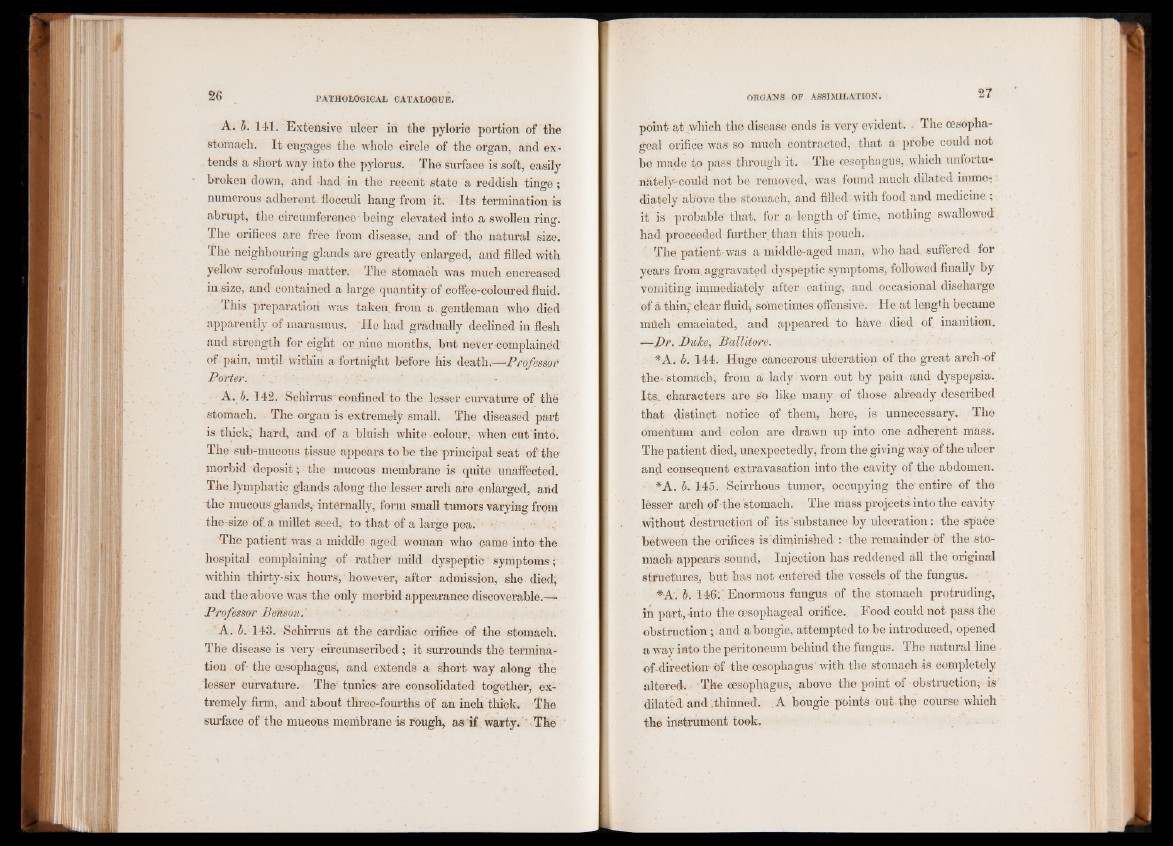
A. h. 141. Extensive ulcer in the pyloric portion of the
stomach. It engages the whole circle of the organ, and extends
a short way into the pylorus. The surface is soft, easily
broken down, and -had in the recent state a reddish tinge ;
numerous adherent-flocculi hang from it. Its termination is
abrupt, the circumference being elevated into a swollen ring.
The orifices are free from disease, and of- the natural size.
Thé neighbouring glands are greatly enlarged, and filled with
yellow scrofulous matter. The stomach was much encreased
in size, and contained a large quantity of coffee-coloured fluid.
This preparation was taken, from a. gentleman who died
apparently of marasmus. He had gradually declined in flesh
and strength for eight or nine months, but never complained1
of pain, until within a fortnight before his death.—Professor
Porter. ' ■ ' -
A. b. 142. Schirrus confined to the lesser curvature of thë
stomach. • The organ is extremely small. The diseased part
is thick, hard, and of a bluish white colour, when cut intó.
The sub-mucous tissue appears to be the principal seat of the
morbid deposit ; the mucous membrane is quite unaffected.
The lymphatic glands along the lesser arch are enlarged, and
the mucous glands,-internally, form small tumors varying from
the -size of. a millet seed, to that of a large pea.
•The patient was. a middle aged woman who came into the.
hospital complaining of rather mild dyspeptic symptoms ;•
within thirty-six hours, however, after admission, she died;
and the above was The only morbid appearance discoverable.—
Professor Benson.'
A. 1. 143. Schirrus at the cardiac orifice of the stomach.
The disease is very circumscribed ; it surrounds thé termination
of the oesophagus, and extends a short way along the
lesser curvature. The'tunics-are consolidated together, extremely
firm, and about three-fourths of an inch thick. The
surface of the mucous membrane is rough, as if warty. ' The
point at which the disease ends is very evident. . The oesophageal
orifice was so much contracted, that a probe could not
be made to pass through it. The oesophagus, which unfortu-
ndtely-could not be removed, was found much dilated imme-:
diatelv above the Stomach, and filled with food and medicine.;.
it is probable' that, for a length of time, nothing swallowed:
had proceeded further than this pouch.
The. patient was a middle-aged man, who had. suffered for
years from, aggravated dyspeptic symptoms, followed finally by
vomiting, immediately after eating, and occasional discharge
of a thin,' clear fluid, sometimes offensive. He at lengt h became
milch emaciated, and appeared to have died of inanition.
>—Dr. Duke, Ballitore.
. *A. b. 144. Huge cancerous ulceration of the great arch -of
the-stomach, from a lady worn out by pain and dyspepsia.
Its. characters are So like many of those already described
that distinct notice of them, here, is unnecessary. The
omentum and colon are drawn up into one adherent mass.
The patient died, unexpectedly, from the giving way of the ulcer
and consequent extravasation into the cavity of the abdomen.
*A. b. 145. Scirrhous tumor, occupying the entire of the
lesser arch of-the stomach. The mass projects into the cavity
without destruction of its'substance by ulceration: the space'
between the orifices is‘diminished : - the remainder of the stomach
appears sound. Injection has reddened all the original
structures, but has not entered the vessels of the fungus.
*-A. b. 146:'. Enormous fungus of the stomach protruding,
in part, -into the oesophageal orifice. Food could not pass the
obstruction ;.and a bougie, attempted to be introduced, opened
a way into the peritoneum behind the fungus. The natural line
of direction of the oesophagus' with the stomach is completely
altered* The oesophagus, .above the point of obstruction;1 is
dilated; and .thinned. A bougie points 'out the course which
the instrument took.